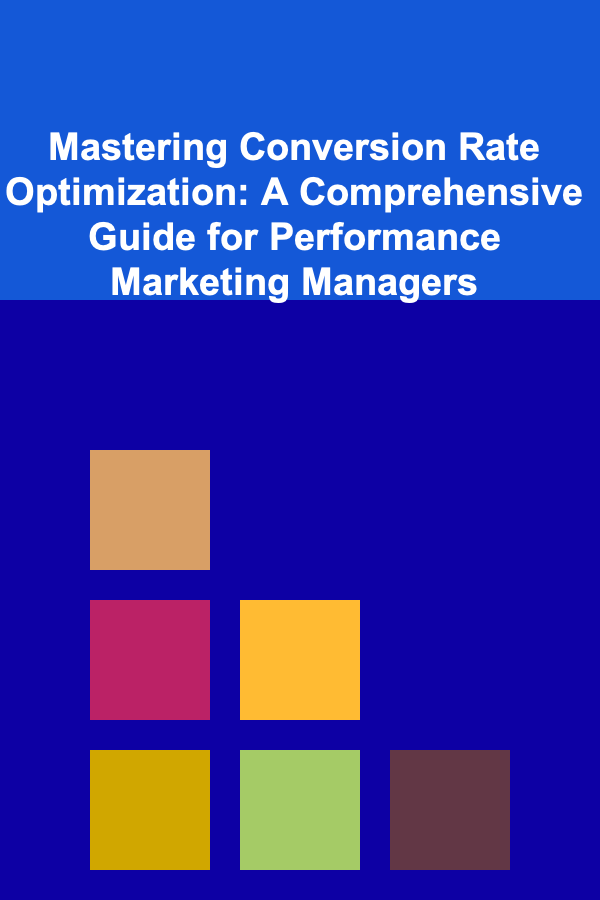
Mastering Conversion Rate Optimization: A Comprehensive Guide for Performance Marketing Managers
ebook include PDF & Audio bundle (Micro Guide)
$12.99$6.99
Limited Time Offer! Order within the next:

In the fast-paced world of digital marketing, driving traffic to a website is only half the battle. The real challenge lies in converting those visitors into customers or leads, and this is where Conversion Rate Optimization (CRO) comes into play. CRO is the process of improving the effectiveness of your website or landing pages by increasing the percentage of visitors who take the desired action, whether it's making a purchase, signing up for a newsletter, or downloading an app.
For Performance Marketing Managers, mastering CRO is essential not only for improving the return on investment (ROI) but also for ensuring that every marketing dollar spent translates into tangible results. This guide will walk you through the principles of CRO, actionable strategies for optimizing your website, and advanced techniques that can help you take your conversion rates to the next level.
Understanding the Basics of CRO
What is Conversion Rate Optimization?
At its core, Conversion Rate Optimization involves improving the percentage of users who complete a desired action on your website or landing page. The action can vary depending on the business model but often includes purchases, sign-ups, form submissions, and other key engagements.
The conversion rate is calculated using the following formula:
Conversion Rate=(Number of VisitorsNumber of Conversions)×100For example, if you had 1000 visitors to your website and 50 of them made a purchase, your conversion rate would be 5%. Even a small improvement in this percentage can have a significant impact on your bottom line.
Why is CRO Important for Performance Marketing Managers?
As a Performance Marketing Manager, your role often involves managing campaigns across various digital channels, such as paid search, social media, and display advertising. The effectiveness of these campaigns is closely tied to the landing pages and websites where users are directed. High traffic without high conversion rates means that you are not getting the most value from your ad spend.
Mastering CRO allows you to maximize your return on investment by ensuring that more of the traffic you're driving turns into actionable outcomes. The key to higher profits isn't always about attracting more visitors but rather improving the conversion rates of your existing traffic.
Key Factors Affecting Conversion Rates
Before diving into the strategies, it's important to understand the key factors that influence conversion rates. By addressing these elements, you can start optimizing for higher conversions.
1. User Experience (UX)
A smooth, intuitive, and frictionless user experience is critical for conversions. If your website is difficult to navigate, slow to load, or lacks clarity, visitors are more likely to leave without completing the desired action. UX encompasses everything from website design to the overall feel of the site and its responsiveness on mobile devices.
2. Website Speed and Performance
Site speed plays a huge role in conversion rates. Studies have shown that a one-second delay in page load time can reduce conversions by 7%. Slow websites frustrate users and lead to higher bounce rates, which negatively impacts your conversion rate.
3. Call to Action (CTA)
Your CTAs are the gateways to conversions. A clear, compelling, and strategically placed CTA can make a significant difference in encouraging users to take action. Whether it's a "Buy Now" button or a "Subscribe" form, it should stand out, be relevant, and align with the user's intent.
4. Trust Signals
Consumers need to feel confident in their decision to convert. Trust signals, such as customer reviews, secure payment options, and clear privacy policies, reassure visitors that they are making a safe and informed decision.
5. Mobile Optimization
With mobile traffic accounting for a significant portion of online visits, ensuring that your website is optimized for mobile users is essential. Mobile optimization affects user experience, and any friction on mobile devices can result in lower conversion rates.
CRO Strategies for Performance Marketing Managers
Now that we have a solid understanding of the key elements that impact CRO, let's dive into actionable strategies you can implement to improve your conversion rates.
1. A/B Testing: The Foundation of CRO
A/B testing (or split testing) is one of the most effective ways to improve conversion rates. By comparing two versions of a webpage or ad, you can identify which elements resonate best with your audience. As a Performance Marketing Manager, this means testing every aspect of your landing pages and ads to fine-tune them for higher conversions.
Key Elements to Test:
- Headlines: Test different headlines to see which one captures your audience's attention more effectively.
- CTA Button: Experiment with different text, colors, and placements for your call-to-action buttons.
- Images and Videos: Different types of visual content may appeal to different segments of your audience.
- Forms: Test form length, field placement, and button design. Reducing friction in form submissions can lead to higher conversions.
By consistently running A/B tests, you will gather data that can help you make informed decisions and continuously improve your landing pages.
2. Optimize Landing Pages for Relevance and Clarity
The relevance and clarity of your landing pages are crucial for conversions. Users should immediately understand what the page is offering and why it's valuable to them. Here are some key tips to optimize your landing pages:
- Consistency: Ensure that the messaging on the landing page aligns with the ad or link that drove the user there. If the ad promises a discount, the landing page should highlight that discount clearly.
- Clear and Concise Copy: Avoid jargon and make your messaging easy to understand. Focus on the benefits of your product or service and how it solves the visitor's problem.
- Minimal Distractions: Remove unnecessary elements from the page. The goal is to keep the user focused on the desired action, whether it's filling out a form or making a purchase.
- Above-the-Fold Information: Place key information, like your unique selling points and CTA, above the fold so users don't have to scroll.
3. Improve Website Speed
Website speed is a non-negotiable factor in CRO. A slow-loading website not only frustrates users but also hurts your SEO efforts. As a Performance Marketing Manager, it's crucial to ensure that your website is optimized for speed, especially since ad campaigns often bring users to the website directly.
Speed Optimization Tips:
- Optimize Images: Large image files can slow down your website. Use image compression tools to reduce file sizes without sacrificing quality.
- Minimize HTTP Requests: Reduce the number of elements on a page that require separate HTTP requests, such as scripts, images, and stylesheets.
- Leverage Caching: Implement browser caching to store frequently accessed resources locally, reducing load times for returning visitors.
- Use a Content Delivery Network (CDN): A CDN helps serve your content from servers located closer to the user, reducing load times.
4. Leverage Social Proof and Trust Signals
To increase conversions, you need to convince users that your product or service is trusted by others. Social proof can take many forms, including customer reviews, testimonials, case studies, and trust badges (such as secure payment icons).
- Customer Reviews: Positive reviews act as a seal of approval for your products. Display reviews prominently on product pages, checkout pages, and landing pages.
- Trust Badges: Show badges from reputable security services (like SSL certificates, trusted payment systems, etc.) to assure users that their data is secure.
- Case Studies and Testimonials: Case studies and customer success stories provide concrete examples of how your product has helped others.
5. Personalize the User Experience
Personalization is one of the most powerful ways to boost conversions. Tailoring your messaging, offers, and recommendations based on user behavior and preferences makes the user feel valued and increases the likelihood of conversion.
- Dynamic Content: Use dynamic content to display different offers or messages depending on the user's past behavior or demographics.
- Product Recommendations: Use machine learning algorithms or manual recommendations to show users products that are similar to what they've already viewed or purchased.
- Email Personalization: Personalize email campaigns based on the customer's browsing history, past purchases, or engagement with previous emails.
6. Retargeting and Remarketing
Not all visitors will convert on their first visit, but that doesn't mean they're lost forever. Retargeting and remarketing are strategies that target users who have already interacted with your website but didn't convert.
- Display Ads: Use retargeting ads on platforms like Google and Facebook to bring users back to your site with tailored offers.
- Email Remarketing: Send personalized follow-up emails to users who abandoned their cart or showed interest in specific products.
Retargeting ensures that your brand remains top of mind and gives you another opportunity to capture conversions from interested visitors.
7. Simplify the Conversion Process
The more steps a user has to take to convert, the lower the conversion rate. A complex or lengthy checkout process, for example, often leads to cart abandonment. Simplify the process wherever possible.
- Reduce Form Fields: The fewer fields a user has to fill out, the higher the chances of conversion.
- Guest Checkout: Allow users to check out as guests without forcing them to create an account.
- Multiple Payment Options: Offer a variety of payment methods (credit cards, PayPal, Apple Pay, etc.) to cater to different user preferences.
8. Analyze and Continuously Optimize
CRO is an ongoing process. After implementing the strategies above, continue to analyze your website's performance and make incremental improvements. Use tools like Google Analytics , Hotjar , or Crazy Egg to track user behavior, heatmaps, and conversion funnels.
Regularly review your data, conduct new A/B tests, and update your strategies based on the latest insights to keep your conversion rates climbing.
Conclusion
Mastering Conversion Rate Optimization is a continuous journey that requires patience, testing, and data-driven decision-making. As a Performance Marketing Manager, your goal should be to improve the user experience, eliminate friction, and continuously refine your tactics to drive better results. By implementing the strategies outlined in this guide, you'll be well on your way to significantly improving your conversion rates and maximizing the effectiveness of your marketing efforts.
CRO isn't just about small tweaks---it's about creating a strategy that aligns with your business goals, audience needs, and market trends. With the right approach, you can optimize every step of the customer journey and turn your website into a high-converting powerhouse.

How to Create a Soundproof Podcast Studio at Home
Read More
How to Organize Your Garage for a More Functional Workspace
Read More
How to Set Intentions for Each Week Mindfully
Read More
How To Apply Stoicism to Finding Joy in Simple Things
Read More
Mastering Chess: A Step-by-Step Strategy
Read More
10 Tips for Curating a Movie Collection Based on Your Mood
Read MoreOther Products

How to Create a Soundproof Podcast Studio at Home
Read More
How to Organize Your Garage for a More Functional Workspace
Read More
How to Set Intentions for Each Week Mindfully
Read More
How To Apply Stoicism to Finding Joy in Simple Things
Read More
Mastering Chess: A Step-by-Step Strategy
Read More